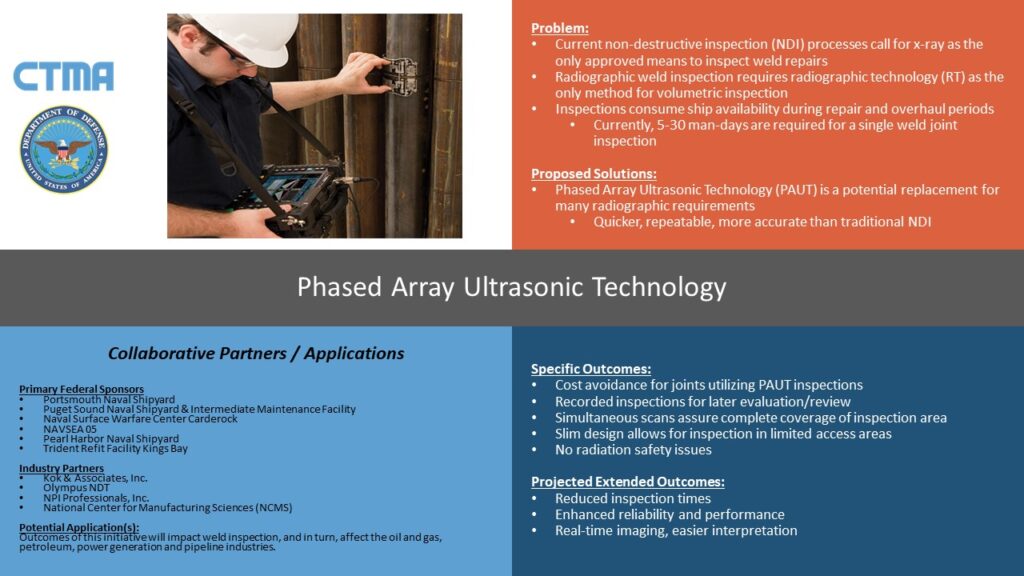CTMA Project #: 140415
Problem: Titanium components are used throughout airframe, armament, and propulsion systems by the U.S. military because of their desirable properties. However, when these components fail prematurely, the cost and logistics impact is significant. Not only is it expensive to replace the titanium components due to the material costs and costly complex fabrication operations, but the loss of a subsystem or a system has even greater impact to systems level cost and overall military readiness. For instance, if the removal of a titanium component results in an “aircraft on the ground – AOG” while the part is being replaced (or repaired, if possible) it can result in loss in mission capability and flight readiness. This program proposes a new solution to the direct repair of worn components with an ultimate goal of creating a small, portable field repair tool.
The timely, in situ repair of such components without degrading the parent material properties offers tremendous opportunities for cost and schedule savings for AOGs and other platforms where titanium components are critical to meeting mission requirements. However, a repair method for titanium alloy components must be highly robust since, in many cases, the choice of titanium has been predicated on the fracture critical nature of the application and/or on exposure to severe environments such as hot gases.
Effective repair approaches have proven difficult to develop as conventional additive metal deposition technologies include a molten phase transformation. The large dimensional changes associated with liquid-solid transformations, and the significant heat input to the surrounding material volumes, result in high residual stresses in the repair area following welding. Furthermore, the Heat Affected Zone associated with traditional joining methods produces a low strength, non-homogenous region at the joint. These changes in the materials properties of the repaired parts are detrimental to the fatigue life, and are a major concern where cyclic loading is experienced. The use of high power ultrasonic consolidation (UC) technologies bypasses the liquid-solid transition and creates a solid state weld or a “cold” joint. This method then allows for strong, homogenous structures to be manufactured and repaired in the field.
Titanium welding, when not in an inert gas shroud, is highly susceptible to oxygen embrittlement and contamination in atmospheric environments above about 400°C. Costly processes such as vacuum melting or inert gas shielding must be taken to protect the weld metal and adjacent base-plate heat-affected zone until sufficient cooling has occurred. The proposed project using UC, an otherwise cold bonding method, mitigates the need for these expensive precautions, thereby bringing down the cost of manufacturing and repair of titanium components.
Benefit: Both the commercial and military participants in this program have stressed the strong potential benefit of this program for both direct titanium fabrication and more specifically, for repair of existing articles. For example, a typical commercial jet airplane contains 700 to 2500-lb. (320 to 1130 kg) of titanium, translating into tens of millions of dollars in repair costs. It has been estimated that the development of an effective field repair method could reduce these costs by as much as 50%. In addition to this, the direct fabrication of prototype and short run production titanium components for consumer products such as golf clubs, bicycles, laboratory equipment, automobiles, wedding bands, and laptop computers can reduce companies time to market by as much as 20%.
While extensive cost savings data is difficult to fully establish, the evidence for the growing demand and use of titanium in the face of limited repair and fabrication technologies is clear.
Solution/Approach: The purpose of this phase is to demonstrate the technical feasibility of this ultrasonic consolidation process on these highly critical applications. Subsequent phases will address getting this process certified by the appropriated agency and to ultimately install this process at the appropriate depot.
Quad Chart:
Impact on Warfighter:
Because of increased usage of Titanium, military ground vehicles can be lighter. Another impact will be increased readiness of all weapon systems utilizing Titanium because of increased reparability utilizing this technology.
DoD Participation:
- Pearl Harbor Naval Shipyard
- Army Research Lab, Aberdeen
Industry Participation:
- Boeing
- Solidica
- Sikorsky
- Edison Welding Institute (EWI)
- NCMS
Benefit Area(s):
- Cost savings





